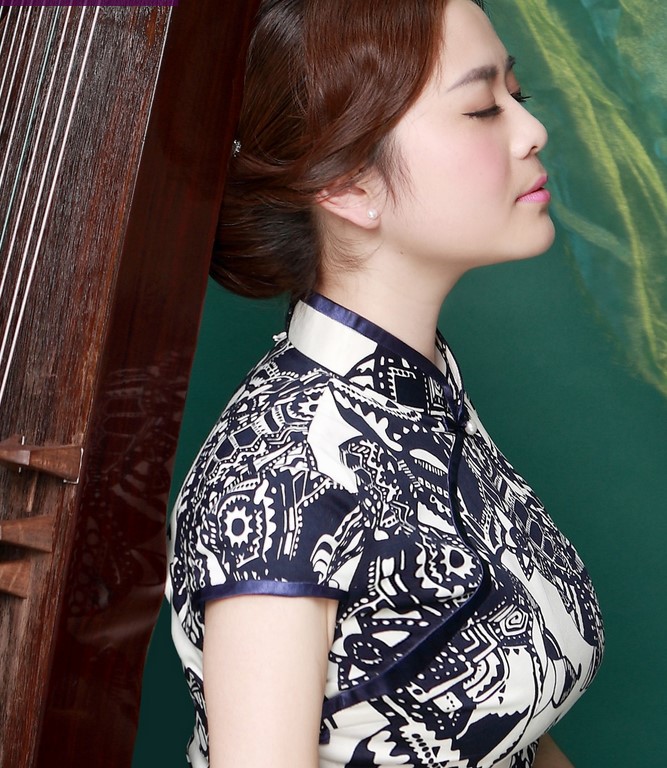Tucson Symphony Orchestra last week offered a concert of mostly 19th-century music composed in France, but the standout piece with guest soloist Jing Xia (pictured) was from China.
Xia, who is based in Newfoundland in eastern Canada, won Album of the Year in 2023 from Music NL. For this performance of the 2007 composition Concerto for Guzheng and Strings by Tan Dun, Xia played the guzheng, an instrument rarely seen at the symphony concert in Western countries. A good portion of the enjoyment in listening to the concerto was the anticipation felt by the audience, who did not know what to expect next.
It begins with what sounds like a rundown clock, followed by a whiny, repetitive melody with a cinematic theme. The first surprise comes early in the concerto, when Xia vocalizes and then exhales for a moment. After an orchestral passage, a solo featuring a rapid glissando of high notes emanates from the guzheng. When the orchestra resumes, it sounds like their pre-concert tune-up. After this disconcerting interlude there is a delicate passage with soloist and the principal violin.
The violins and bass take over for the silent soloist in a passage redolent of 1950s Hollywood films set in Asia. Low notes on the bass and double bass herald a new theme where the violinists use their hands to pluck and beat the strings. This mode of playing is then taken up by all the string instruments.
Towards the end we are treated to a dramatic cacophony, invoking high anxiety. The strings go into a frenzy. In a helter-skelter passage, all the orchestra members vocalise. The sense of impending doom certainly got the heartbeat racing as the concerto concluded.
I asked Tucson music critic Conlan Salgado for his analysis of the concerto, which the programme notes state was inspired by China’s 4000-year-old ‘Ghost Opera’ tradition. “There are several beautiful moments in the concerto. When you listen to modern pieces it’s like people had just discovered sound. Half the time the way they are using it is ugly, a quarter of the time it’s interesting and a quarter of the time it’s beautiful. That how I felt about the concerto.”
“I was listening to a lecture about philosophy recently. The man who giving it said Schopenhauer (the 19th century German philosopher) had this idea that music didn’t need to be translated. For example, if someone who doesn’t know English wants to read Shakespeare, English has to be translated into another language. It isn’t like that with music: it’s just the will transcribing itself. The point is, if you listen to a piece of music like that, if you were just listening without reading the notes, you can say this is a piece that harkens back to the 4,000-year-old tradition of Chinese shamans. Ok, but what about just as a piece of music? Whenever you have to give a verbal explanation for why a piece of music sounds this way, you’re already on the wrong track.
“But that being said, there were certain moments that were really beautiful, particularly when the instrument was solo. The best parts of the concerto were when the soloist was playing with either the cello or the violin by itself. You also saw a lot of typical modern composer themes, such as throw in a bunch of weird sounds like the stomp (which began the concerto) and the shouts, and the crazy glissandi. Nonetheless, it is worth listening to, if only for those soloistic moments. It was a really interesting piece, I just wish there had been larger solo elements.”
Following this was a 1901 composition by Gabriel Fauré, entitled Pelléas et Mélisande. This 18-minute piece was last performed by TSO in 2014. Unusually, the oboe leads the first movement, while the harp is featured in the third. Remarkably, the fourth and final movement was played at the funeral of the composer in 1924. One can hardly call this an uplifting composition, but it’s delicacy was in stark contrast to the often bombastic Chinese concerto. I’m sure many in the audience were glad to get back to the familiar ground of French music, and this was reinforced by the charming Petite Suite by Debussy. This piece, from 1889, is most notable for its rousing 2nd movement. Complete with cymbals, it was quite triumphalist in tone, superbly delivered by the TSO in the music auditorium at Catalina Foothills High School.
Kudos for the Tucson Symphony for offering a musical composition outside the European canon. This performance was appropriately under the baton of Sunny Xia, who hails from China. She is currently Associate Conductor at the Seattle Symphony.
Note on the composer: Tan Dun won an Academy Award for his score to the film Crouching Tiger, Hidden Dragon.
For more on upcoming performances by this cultural gem of the desert, visit the website: TucsonSymphony.org
